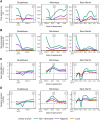Improving early epidemiological assessment of emerging Aedes-transmitted epidemics using historical data
- PMID: 29864129
- PMCID: PMC6002135
- DOI: 10.1371/journal.pntd.0006526
Improving early epidemiological assessment of emerging Aedes-transmitted epidemics using historical data
Abstract
Model-based epidemiological assessment is useful to support decision-making at the beginning of an emerging Aedes-transmitted outbreak. However, early forecasts are generally unreliable as little information is available in the first few incidence data points. Here, we show how past Aedes-transmitted epidemics help improve these predictions. The approach was applied to the 2015-2017 Zika virus epidemics in three islands of the French West Indies, with historical data including other Aedes-transmitted diseases (chikungunya and Zika) in the same and other locations. Hierarchical models were used to build informative a priori distributions on the reproduction ratio and the reporting rates. The accuracy and sharpness of forecasts improved substantially when these a priori distributions were used in models for prediction. For example, early forecasts of final epidemic size obtained without historical information were 3.3 times too high on average (range: 0.2 to 5.8) with respect to the eventual size, but were far closer (1.1 times the real value on average, range: 0.4 to 1.5) using information on past CHIKV epidemics in the same places. Likewise, the 97.5% upper bound for maximal incidence was 15.3 times (range: 2.0 to 63.1) the actual peak incidence, and became much sharper at 2.4 times (range: 1.3 to 3.9) the actual peak incidence with informative a priori distributions. Improvements were more limited for the date of peak incidence and the total duration of the epidemic. The framework can adapt to all forecasting models at the early stages of emerging Aedes-transmitted outbreaks.
Conflict of interest statement
The authors have declared that no competing interests exist.
Figures






Similar articles
-
Unlike Zika, Chikungunya virus interferes in the viability of Aedes aegypti eggs, regardless of females' age.Sci Rep. 2020 Aug 12;10(1):13642. doi: 10.1038/s41598-020-70367-6. Sci Rep. 2020. PMID: 32788625 Free PMC article.
-
Seasonal temperature variation influences climate suitability for dengue, chikungunya, and Zika transmission.PLoS Negl Trop Dis. 2018 May 10;12(5):e0006451. doi: 10.1371/journal.pntd.0006451. eCollection 2018 May. PLoS Negl Trop Dis. 2018. PMID: 29746468 Free PMC article.
-
A comparative analysis of Chikungunya and Zika transmission.Epidemics. 2017 Jun;19:43-52. doi: 10.1016/j.epidem.2017.01.001. Epub 2017 Jan 18. Epidemics. 2017. PMID: 28139388
-
The Convergence of a Virus, Mosquitoes, and Human Travel in Globalizing the Zika Epidemic.J Community Health. 2016 Jun;41(3):674-9. doi: 10.1007/s10900-016-0177-7. J Community Health. 2016. PMID: 26969497 Review.
-
Human Urban Arboviruses Can Infect Wild Animals and Jump to Sylvatic Maintenance Cycles in South America.Front Cell Infect Microbiol. 2019 Jul 17;9:259. doi: 10.3389/fcimb.2019.00259. eCollection 2019. Front Cell Infect Microbiol. 2019. PMID: 31380302 Free PMC article. Review.
Cited by
-
Estimation of SARS-CoV-2 mortality during the early stages of an epidemic: A modeling study in Hubei, China, and six regions in Europe.PLoS Med. 2020 Jul 28;17(7):e1003189. doi: 10.1371/journal.pmed.1003189. eCollection 2020 Jul. PLoS Med. 2020. PMID: 32722715 Free PMC article.
References
-
- Breban R, Riou J, Fontanet A. Interhuman transmissibility of Middle East respiratory syndrome coronavirus: estimation of pandemic risk. The Lancet. 2013;382(9893):694–699. doi: 10.1016/S0140-6736(13)61492-0 - DOI - PMC - PubMed
-
- Poletto C, Pelat C, Lévy-Bruhl D, Yazdanpanah Y, Boëlle P, Colizza V. Assessment of the Middle East respiratory syndrome coronavirus (MERS-CoV) epidemic in the Middle East and risk of international spread using a novel maximum likelihood analysis approach. Eurosurveillance. 2014;19(23):20824 doi: 10.2807/1560-7917.ES2014.19.23.20824 - DOI - PubMed
-
- Cauchemez S, Fraser C, Van Kerkhove MD, Donnelly CA, Riley S, Rambaut A, et al. Middle East respiratory syndrome coronavirus: quantification of the extent of the epidemic, surveillance biases, and transmissibility. The Lancet infectious diseases. 2014;14(1):50–56. doi: 10.1016/S1473-3099(13)70304-9 - DOI - PMC - PubMed
-
- WHO Ebola Response Team. Ebola virus disease in West Africa—the first 9 months of the epidemic and forward projections. N Engl J Med. 2014;371(16):1481–1495. doi: 10.1056/NEJMoa1411100 - DOI - PMC - PubMed
-
- Althaus CL. Estimating the reproduction number of Ebola virus (EBOV) during the 2014 outbreak in West Africa. PLoS currents. 2014;6 doi: 10.1371/currents.outbreaks.91afb5e0f279e7f29e7056095255b288 - DOI - PMC - PubMed
MeSH terms
LinkOut - more resources
Full Text Sources
Other Literature Sources
Medical
Miscellaneous

